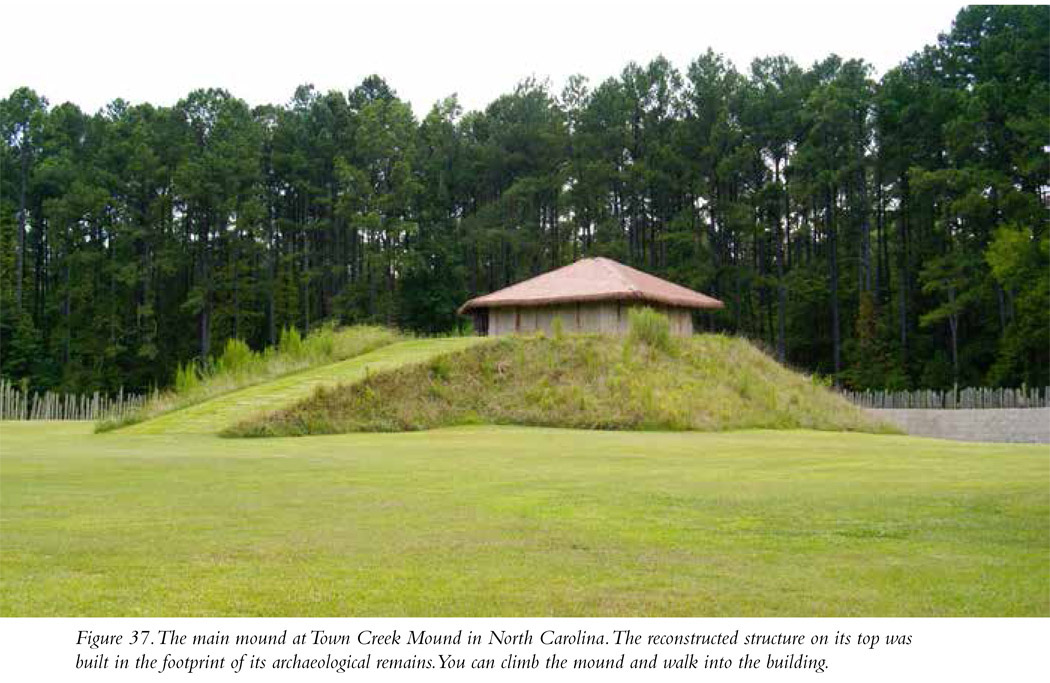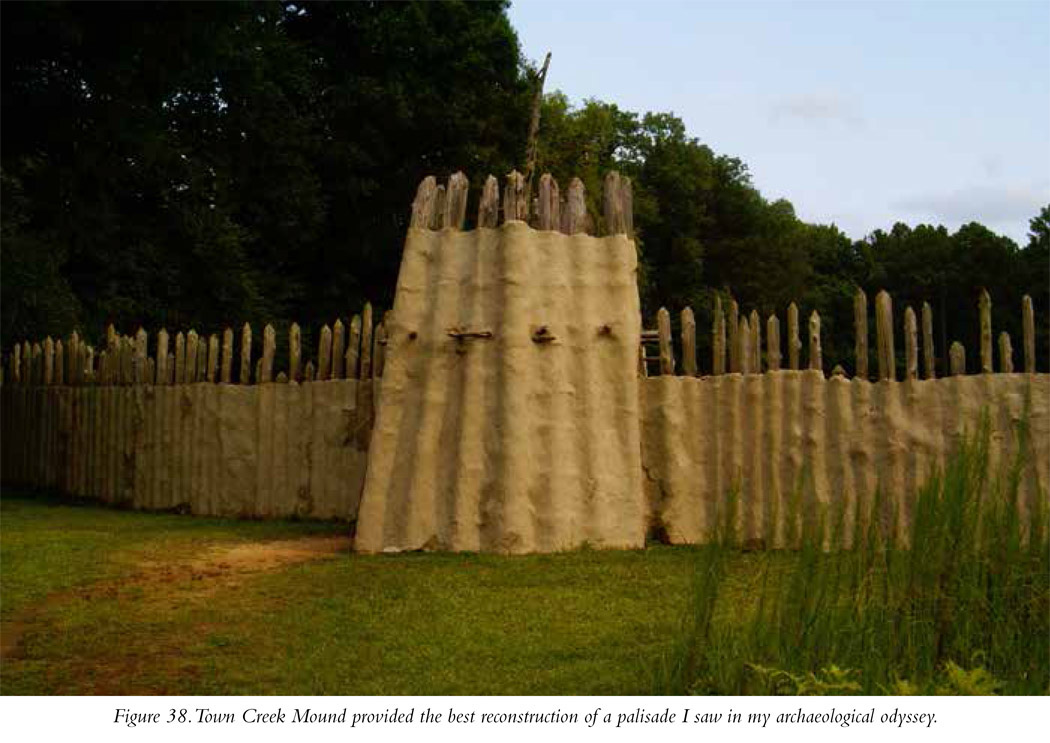
Mount Gilead, North Carolina
Journal Entry
August 14, 2008
It took us two days of driving from Connecticut in the southeastern leg of my odyssey, but we finally arrived at Town Creek Mound, a medium-size but very impressive mound site located near the town of Mount Gilead, North Carolina. Built a thousand years ago, Town Creek was a ceremonial center with a single small temple mound surrounded by a large plaza and the archaeological remains of hundreds of burials. The state has done a terrific job of keeping up the site, and there is a pretty well-done reconstruction of the temple located on top of the extant mound as well as the surrounding palisade. The palisade is particularly impressive and surrounds virtually the entire site. The setting and the site itself are beautiful, and there’s a very worthwhile museum. Town Creek Mound was the first site formally excavated by archaeologists in North Carolina. It has been designated a National Historic Landmark.
What You Will See
At the Town Creek Mound site you will see the archaeological remnants of an impressive village occupied between AD 1150 and AD 1400. The primary mound is in terrific condition, with a ramp that allows you to walk to the top. On the top is a replicated temple that you are free to enter. They’ve done a terrific job of reproducing the temple; the ceiling and room, consisting of a superstructure of thin, long logs overlain by thatch, is a work of art (Figure 37).


There are a number of other replicated features at Town Creek. Along with the temple on top of the big platform mound, the palisade that surrounded the community has been partially rebuilt, giving you a good idea of what the enclosed village looked like a thousand years ago (Figure 38). Most of the reconstruction consists of just upright logs sunken into the ground and rising more than 10 feet above the surface. Part of the palisade has been more completely reconstructed, with horizontal cross pieces of branches and saplings woven into the vertical elements. These parts of the wall have then been finished with a coating or material to make a more or less smooth wall on both the interior and exterior. Originally this coating might have been mud, which would have required nearly constant work to maintain. I’m not sure what material was used in making the replica wall, but it’s not mud. Based on the post-molds discovered during the site’s excavation, archaeologists noted the presence of a number of bastions along the palisade. These represent small add-ons jutting to the outside of the enclosed area where, in all likelihood, warriors would have been posted as lookouts, providing them platforms from which they might defend the village from possible attackers.
A typical house has also been replicated, where you can see the nature of Town Creek residential architecture. Some parts of the house walls have been left unfinished, enabling a close look at the process of wattle-and-daub construction much like the palisade. There is also a reconstructed burial building. There’s a very nice on-site museum, but what’s really great about this site are the tour guides. When I visited, one of them (John) took us around the site, and you couldn’t ask for a better informed or more enthusiastic guide.
Why Is Town Creek Important?
Located in North Carolina, Town Creek Mound reflects the vast geographic extent of the temple mound building culture of native America, one of the best-kept secrets of American history. Mound builder sites are found across the American Midwest and Southeast; there is even a mound builder outpost in Wisconsin (see Site 22, Aztalan later in this section). Admit it; most of you have probably not heard of mound-building Indians living in densely populated, urban-like settlements. Abandon stereotypes you might have harbored about Native American culture and visit Town Creek, where a large, complex community produced monumental structures like the primary temple mound and the palisade.
Town Creek Mound is a nice example of a small but significant ceremonial center of the temple mound building cultures. Town Creek was not a large city with a big population. It was instead the community in which lived the religious, social, and political elites—the big shots, the 1 percenters. Based on the archaeology conducted on and off at the site (some professional; some, unfortunately, little more than pillaging and pot hunting), as well as historical information supplied by local Indians, a broad area around the location of Town Creek was inhabited by a large number of agricultural villages whose inhabitants viewed the people living at the large site as their rulers and priests. Perhaps yearly, the members of the Town Creek nation would have congregated there for practical reasons—fixing the palisade, for example—but also for ceremonial reasons including feasting and religious ceremonies. People in the surrounding region might also have come together at Town Creek for the funerals of the people deemed important enough to be buried at their capital. To date, the remains of 563 people have been found buried at Town Creek, including small children and babies.
Site Type: Platform Mound
Wow Factor: *** The primary mound is beautiful, and the reconstructed house at its apex is cool. The reconstructed part of the palisade around the site, replete with bastions, is far and away the best I have seen and gives you a very good idea of what those city walls looked like at mound builder villages across the Southwest and Midwest.
Museum: ****
Ease of Road Access: *****
Ease of Hike: *****
Natural Beauty of Surroundings: ****
Kid Friendly: **** Plenty of territory for kids to explore. And kids will enjoy entering the reconstructed house atop of the main mound.
Food: Bring your own.
How to Get There: Town Creek Mound is located in Montgomery County, North Carolina, about 5.5 miles from the town of Mount Gilead on, predictably, Town Creek Mound Road. The closest cities are Greensboro and Charlotte (about 1.5 hours away) and Raleigh and Durham (about a 2-hour drive).
Hours of Operation: Open Tuesday through Saturday 9 a.m. to 5 p.m.; Sunday 1 to 5 p.m. Closed Monday and major holidays.
Cost: Free, but donations are accepted.
Best Season to Visit: Hot and humid in summer
Website: www.nchistoricsites.org/town/town.htm
Designation: State Historic Site; National Historic Landmark